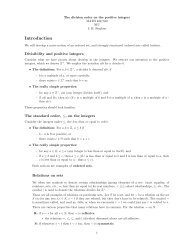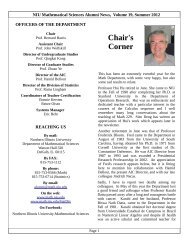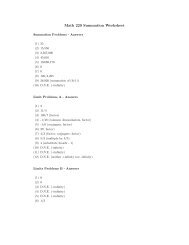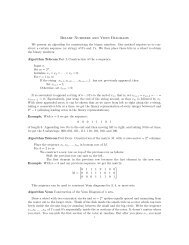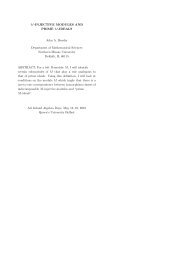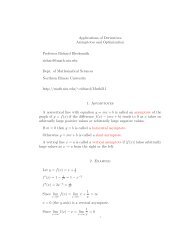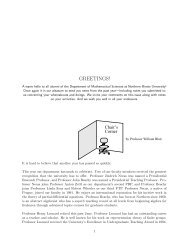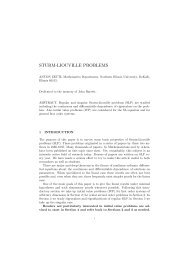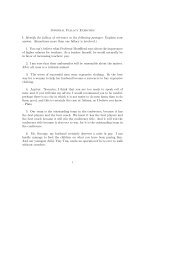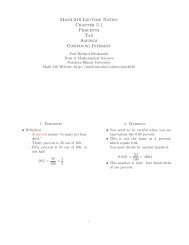abstract algebra: a study guide for beginners - Northern Illinois ...
abstract algebra: a study guide for beginners - Northern Illinois ...
abstract algebra: a study guide for beginners - Northern Illinois ...
Create successful ePaper yourself
Turn your PDF publications into a flip-book with our unique Google optimized e-Paper software.
42 CHAPTER 3. GROUPS<br />
3.7 Homomorphisms<br />
In Section 3.4 we introduced the concept of an isomorphism, and studied in detail what it<br />
means <strong>for</strong> two groups to be isomorphic. In this section we look at functions that respect the<br />
group operations but may not be one-to-one and onto. There are many important examples<br />
of group homomorphisms that are not isomorphisms, and, in fact, homomorphisms provide<br />
the way to relate one group to another.<br />
The most important result in this section is Theorem 3.7.8, which is a preliminary <strong>for</strong>m of<br />
the Fundamental Homomorphism Theorem. (The full statement is given in Theorem 3.8.9,<br />
after we develop the concepts of cosets and factor groups.) In this <strong>for</strong>mulation of the<br />
Fundamental Homomorphism Theorem, we start with a group homomorphism φ : G1 → G2.<br />
It is easy to prove that the image φ(G1) is a subgroup of G2. The function φ has an<br />
equivalence relation associated with it, where we let a ∼ b if φ(a) = φ(b), <strong>for</strong> a, b ∈<br />
G1. Just as in Z, where we use the equivalence relation defined by congruence modulo n,<br />
we can define a group operation on the equivalence classes of ∼, using the operation in<br />
G1. Then Theorem 3.7.8 shows that this group is isomorphic to φ(G1), so that although<br />
the homomorphism may not be an isomorphism between G1 and G2, it does define an<br />
isomorphism between a subgroup of G2 and what we call a factor group of G1.<br />
Proposition 3.7.6 is also useful, since <strong>for</strong> any group homomorphism φ : G1 → G2 it describes<br />
the connections between subgroups of G1 and subgroups of G2. Examples 3.7.6 and<br />
3.7.7 are important, because they give a complete description of all group homomorphisms<br />
between two cyclic groups.<br />
SOLVED PROBLEMS: §3.7<br />
21. Find all group homomorphisms from Z4 into Z10.<br />
22. (a) Find the <strong>for</strong>mulas <strong>for</strong> all group homomorphisms from Z18 into Z30.<br />
(b) Choose one of the nonzero <strong>for</strong>mulas in part (a), and <strong>for</strong> this <strong>for</strong>mula find the kernel<br />
and image, and show how elements of the image correspond to cosets of the kernel.<br />
23. (a) Show that Z × 11<br />
(b) Show that Z × 19<br />
is cyclic, with generator [2]11.<br />
is cyclic, with generator [2]19.<br />
(c) Completely determine all group homomorphisms from Z × 19 into Z× 11 .<br />
24. Define φ : Z4 × Z6 → Z4 × Z3 by φ(x, y) = (x + 2y, y).<br />
(a) Show that φ is a well-defined group homomorphism.<br />
(b) Find the kernel and image of φ, and apply the fundamental homomorphism theorem.<br />
25. Let n and m be positive integers, such that m is a divisor of n. Show that φ : Z × n → Z × m<br />
defined by φ([x]n) = [x]m, <strong>for</strong> all [x]n ∈ Z × n , is a well-defined group homomorphism.



